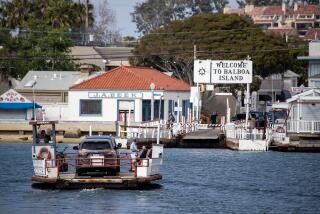Famed ferry system now a vessel for ads
- Share via
BAINBRIDGE ISLAND, WASH. — With the exception of those who travel by floatplane or private boat, everyone who travels to the San Juan Islands depends on Washington’s signature green-and-white state-run ferries. Famously included in the price of a ticket to the remote islands are panoramic, near-pristine vistas.
Starting this year, the Washington state ferry system is injecting a decidedly corporate element to its floating armada: advertising -- boatloads of it.
Along with scenic Puget Sound and mountain views, the ferries will be serving commercial appeals, on tabletops, walls, floors, stairwells, overhead banners, doors, car decks, passenger decks and ferry terminals.
Signage will be posted throughout the 20-terminal, 28-vessel network -- including routes serving Friday Harbor, Bainbridge Island, Whidbey Island, Bremerton, Vashon Island, Port Townsend and all other Puget Sound destinations -- to shore up revenue.
--
Riders react
A dozen billboard-size product pitches and several smaller ones already grace the car deck, passenger deck, stairwells and doors on the jumbo ferry Tacoma.
On one recent crossing from Bainbridge Island to Seattle, tourists’ and commuters’ reactions swung from ho-hum to seasick.
Lynette Hagen, a small-business owner from Poulsbo, loathed the floor-to-ceiling lime green and bright orange wall billboard next to a seating area.
“It’s too big, not subtle. It clutters everything up,” she said, glaring at the Washington Mutual marketing. “Don’t we get enough of that on TV? Ferry-riding is supposed to be relaxing.”
Cecile Lutz, 86, visiting a great-grandchild, didn’t mind.
“You can learn a lot from ads,” the Hansville resident said, “as long as they are nice.”
Sightseers Robin Anderson and Dan Kozar of Chicago thought the ad blitz belonged on land, back in the terminals, not over the water.
Ferry officials used to prohibit commercial advertising except for racks of tourist brochures; only Native American art, historical displays, maps and homeland security posters brightened ferryboat walls.
But cash-starved and struggling to maintain an aging fleet, officials needed extra money to run the largest ferry network in the United States. It serves 26 million passengers each year.
Budget woes have vexed the system for years. A key source of funding disappeared when voters approved Initiative 695 in 1999. It replaced the state’s lucrative motor-vehicle excise tax with a flat fee. A state audit last September suggested cutting lesser-used ferry runs to save money.
--
‘We want to make it cool’
Selling advertising represents a means to “decrease our dependency on subsidies,” said Jayne E. Davis, ferry system regional operations manager.
“We are aware that people may find certain advertising offensive,” Davis said.
“We want to make it cool for people and improve the ride on the boat.”
The ferry system has a two-year operating system budget of $428.6 million. Officials declined to say how much they expect the advertising program to bring in.
So far this year, with four introductory advertisers, they made about $165,000.
--
What advertisers get
In a pitch, the state’s ad agency tells prospective advertisers that the boats provide “iconic value, captive audience, positive relaxed advertising environment and opportunity to interact with passengers.”
At the Seattle Ferry Terminal at Colman Dock, a collection of oversize Lufthansa Airlines promotions greets travelers. A large sign for the German airline hangs over the main ticket counter. Others adorn the structure’s walls and floors.
All that advertising degrades public space, said Robert Weissman, managing director of Commercial Alert, a Washington, D.C., watchdog group.
The ads will “force-feed advertisers to passengers and contribute to excessive commercialism,” Weissman said.
“These schemes are attractive to those who control public assets, because they offer the illusion of free money,” he said. “The money does not come for free, however. The advertisers pay because they are getting something -- access to a captive audience.”
Thus far, no organized protests have emerged against commercials on the Pacific Northwest nautical icons.
The ad sales campaign is still in its beginning stages.
“We are just seeing how it develops,” said Marta Coursey, ferry system communications director.
“We do know the public supports this. The public applauds the ferry system’s efforts to support itself.”
--
More to Read
Sign up for The Wild
We’ll help you find the best places to hike, bike and run, as well as the perfect silent spots for meditation and yoga.
You may occasionally receive promotional content from the Los Angeles Times.





